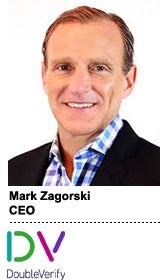Ad verification company DoubleVerify went public on Wednesday, a month after it filed an S-1, and a week after it set the terms for the IPO, which had it valued at $4.2 billion.
However, the company’s stock opened at $35 a share – nearly 30% above its IPO price – valuing the company at more than $5 billion, according to MarketWatch.
DoubleVerify – which was founded in 2008 and tracks digital media engagement – is the latest ad tech company to go public, and its IPO comes after a strong 2020 in which gross revenue increased 34% to $244 million.
Its tech is designed to detect ad fraud, ensure ad viewability and brand safety, and the company has been in growth mode in recent years, during which it acquired contextual intelligence platform Leiki. It’s also been pushing into the sell-side – it purchased Ad-Juster in 2019.
AdExchanger spoke with DoubleVerify CEO Mark Zagorski, former CEO of Telaria, which was public before being acquired by Rubicon Project to form Magnite. Zagorski joined DV last year and discussed the company’s plans for growth, how the IPO will give it a competitive edge and why ad fraud is not going away anytime soon.
ADEXCHANGER: Why is it important to IPO now, and how is it going to give DoubleVerify a competitive edge?
MARK ZAGORSKI: We’re coming off a really strong year. It put us in a really nice spot. And the problems that we’re trying to solve for digital advertisers – issues around fraud and brand safety – those things are not going away. In the last year, they’ve continued to become bigger problems for advertisers.
With the great momentum we’ve had and what’s happening in the marketplace, it was a cue that it was a good opportunity for us to build a new stream of investment that allows us to fuel our growth and support our clients by investing in technology and accelerating our technology roadmap.
As emerging sectors like CTV, audio and others continue to be challenged by brand safety and fraud issues, our ability to expand in a global market has never been more important. It was the right time for us to tap into the public markets and start building a war chest to go out and expand our business.
What will the company’s growth strategy look like?
We’re going look at organic growth, where we can start building things on our own. And that involves people — we’ll be adding almost 200 people this year to the roster. And then we’ll look at opportunistic M&A that can help accelerate our roadmap or help us grow globally.
Are there any holes you need to fill in your portfolio?
We really take the cues from our brand partners who may say, “We’re going to spend a lot more money on audio this year, or CTV is going to be big for us this year.” We try to be a little bit ahead of them.
Will DoubleVerify continue its push into the sell side?
Yes. Our publisher toolset is not just a great business for us but it’s a strategic investment as well. We want to ensure that we have great relationships with publishers on the open web and providing tools to help them optimize and legitimize the work they’re doing with advertisers as well.
There seems to be a frenzy around ad tech these days. What’s going to keep it from being a bubble? And how do you ensure continuous growth?
We are highly profitable and growing. There’s also a very big distinction between folks that only work in the open web and those that have the ability – like DoubleVerify – to work with walled gardens and closed platforms.
We’re not fighting for wallet share over what FANGs [Facebook, Amazon, Netflix and Google] have left on the table. We work across the spectrum and being agnostic is not fighting for media dollars. I think, from a macro perspective, advertising technology companies are in much, much better shape.
How does DoubleVerify stay competitive and differentiate itself from competitors like IAS and Oracle’s Moat?
It’s really us and IAS. Moat has really been marginalized to be a point player. They’ve fallen into the Oracle box. And I think when we talk about our solution, the differentiation is the breadth and depth in which we approach the marketplace.
We are not just analyzing fraud on programmatic platforms or fraud on video, or mobile or display, we look at all digital ad fraud. We have a very broad purview. Our verification and invalid traffic analysis is the most accredited out there – we have the most MRC accreditations out there across the board.
Is ad fraud becoming less of a problem as digital advertising matures?
I would love to say that as the industry matures, fraud is no longer an issue. But fraud just morphs. The same fraud schemes that we saw in display evolved into fraud schemes across mobile, and those same mobile fraud schemes are now attacking CTV.
We see a lot of it in CTV today and we’ll probably see fraud in audio streaming and podcasts.
Is there an opportunity around brand safety that’s larger than detecting fraud? What makes you think brand safety and risk is really a great business?
I think they are equally top of mind for advertisers.
As we’ve seen over the last 12 to 18 months, advertisers are just as concerned about where their ad goes as what their ad says. And that’s not changing – if anything, it become heightened as brands have been challenged to take a stand on controversial or pressing social issues. At the end of the day, the lack of transparency between buyers and sellers is only getting greater as programmatic continues to grow. That means verification tools like ours become increasingly important.
How do you feel about being a public market CEO again after your time at Telaria?
I’m excited. Being in the public market is great – it’s a constant justification and verification of what you’re doing as a business. We really are adamant about our vision of creating a more safe and secure digital ecosystem, and driving this fair value transaction between buyers and sellers. And to get a higher profile in the public market, by bringing in great investors and being able to talk to a broader audience, it’s really powerful.
This interview has been edited and condensed.















